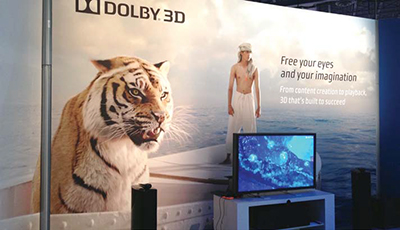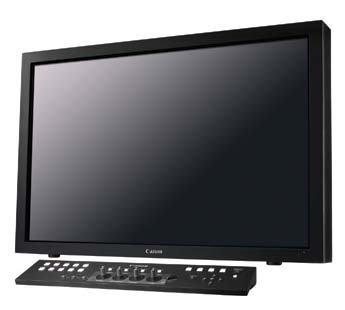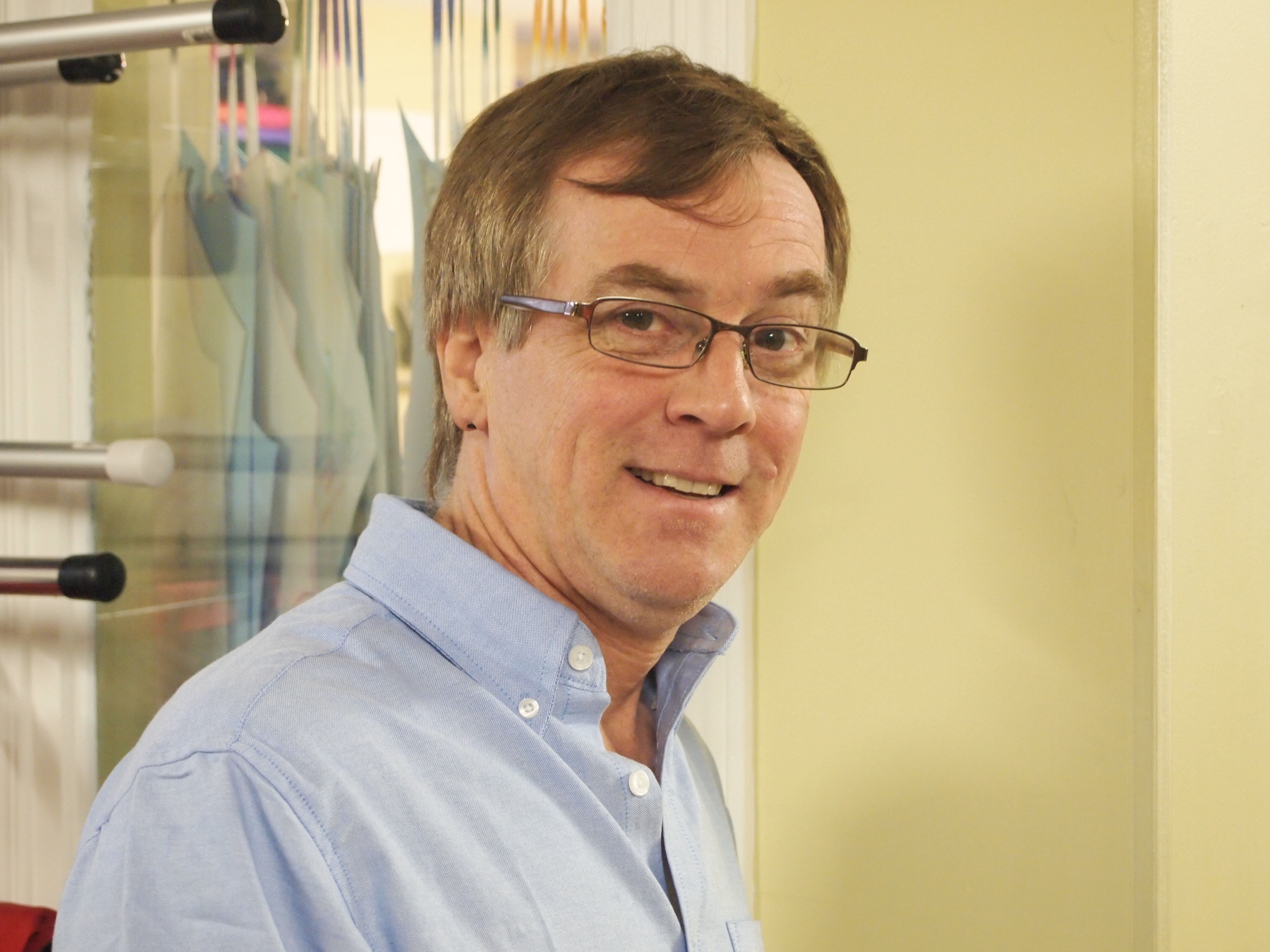Monitors Continue Evolution to OLED, 4K

Dolby demonstrated Its Dolby Vision display technology at its NAB Show booth.
LAS VEGAS—There are two trends about professional monitors that broadcast engineers need to know about: OLED and 4K.
The move to OLED displays for high precision video monitoring. Short for organic light-emitting diode, OLED displays employ semiconductors with organic film layers that emit light when current flows through them; compared to inorganic light-emitting diodes used as illumination sources in LCD displays (also referred to as LED displays). OLEDs offer faster response time, lower black levels, and wider viewing angles/ color gamuts than LCD monitors.
“OLED technology is still the leader for broadcast and production monitors,” said Lee Blanco, director of engineering at All Mobile Video in New York. “I would install OLEDs wherever critical video monitoring is required. I would go with lower-cost LEDs in less critical areas such as display walls.”
This said, OLED monitors are more expensive than LCDs. The good news for cash-strapped broadcasters is that there are some LCD monitors that are good enough for critical monitoring; even if they don’t have the deep black levels and wide viewing angles of OLEDs.
“The Panasonic and Canon monitors fall into this category,” said Pete Putman, president of Roam Consulting in Doylestown, Penn. “Both companies use IPS [in-plane switching] glass, which is the best alignment system for professional LCD monitors. Sony’s Pro LCDs also use IPS, as do most of the TV Logic monitors.”
The second trend is 4K monitoring, or rather a hesitance to move to 4K. “My general feeling is that the cost of 4K displays is still very high,” said Dave Greany, engineering manager at the mobile units division of NEP Inc. in Pittsburgh. “If someone had shown a quad-split feed for a monitor-grade 4K display at NAB, I might have been interested—because this would let us display four 1080p multiviewer outputs on a single larger 4K screen.
“Even a consumer-grade 4K monitor for a few thousand dollars that had that ability, versus tens of thousands for a professional-grade 4K display, would allow us to capitalize on the higher resolution; in turn providing our clients with higher quality multiviewer displays,” Greany added. “Given how limited 4K sports production work currently is, buying professional 4K models doesn’t stack up.”
An interim solution for such capabilities could be found from several companies, justifying the case for buying 4K monitors now, and using them to display multiple 1080p video feeds until 4K becomes commonplace. Marshall’s QVW-2710 27-inch monitor features four independent 3G-SDI inputs, allowing users to view full 4K (4096 x 2160) or UHD (3048 x 2160) formats. The four 3G-SDI inputs can also be used to quad-view four different 1080p feeds, each one coming from a different source.
A similar solution from Apantac includes the Ultra-DE-4K 4K Universal Multiviewer, which can display four 1080p images on a single 4K screen, among other windowing options. This means the user can buy a 4K screen today and put it to work, knowing that the Apantac Ultra-DE-4K will be useful when 4K takes hold.
MONITORS THAT MERIT MENTION
The fact that these experts didn’t see radically new monitors at the NAB Show does not mean that some products did not catch their eye—because some did.
A case in point: Sony demonstrated its yet-unbranded 30-inch professional 4K OLED monitor. Due for release in the fall of 2015, this 4K monitor offers 4096 x 2160 pixel resolution and color reproduction with a wide color space suited to the ultra high-definition standard (ITU-R BT.2020). Putman was impressed by what Sony was showing, but quipped that the Japanese company was “still trying to figure out how much someone will pay for it.”

Canon’s DP-V3010 4K reference display Putman was more impressed by what he saw at Panasonic’s NAB booth. The company has “successfully transitioned away from industrial plasma with two new, large 4K monitors; an 84-inch LCD and a 98-inch LCD,” he said. “The glass for both comes from LG Display. They’re also showed the 80-inch Sharp LCD display with a touchscreen overlay as a Panasonic product. And of course, Panasonic has its own 31.5 inch 4K reference monitor now, made in the company’s Himeji Gen 8 LCD fab.”
4K also had the spotlight at other major manufacturers’ booths. For instance, “Canon showed their 30-inch IPS 4K reference monitor,” Putman said. “This is a ‘homebrew’ product. I think the LCD panel comes from Japan Display Inc, a business that Canon once had an investment in when it was run by Hitachi.”
JVC showed some 4K Versa monitors; including an 84-inch LCD model that uses LG Display panels. Putman also saw a 25- inch OLED monitor at TV Logic’s booth: “They buy the panels from Sony,” he said. “And Dolby showed its Philips-made autostereo monitor—42 inches, I think— which they’ve had in the past.”
NEP’s Greany was looking for specialized 16:10 ratio monitors for his company’s trucks. “The 16:10 displays let you show 16:9 images properly, plus they leave space for IMD information at the bottom of each multiviewer window,” he explained.
Greany’s attention was caught by Boland’s new 24-inch HXL24 16:10 display panel. “Along with their 32-inch 16:10 model, Boland’s 24-inch16:10 fits nicely into the tight spaces of a production truck, while giving us the extra screen space to display IMD information,” he said. “They have SFP slots on the back of these monitors, so that you can eliminate the external fiber adaptor historically stuck on the back of each display.”
Collectively, these video experts didn’t see anything mind-shattering in the way of new displays at NAB, but they did see some products (noted above) worthy of broadcast engineer consideration. The watchwords for those companies making new monitor purchases in the wake of this year’ convention are choosing OLED or IPS LED displays for critical monitoring, and remaining conservative about moving to 4K unless there’s a demonstrated need for this capability.
Get the TV Tech Newsletter
The professional video industry's #1 source for news, trends and product and tech information. Sign up below.
James Careless is an award-winning journalist who has written for TV Technology since the 1990s. He has covered HDTV from the days of the six competing HDTV formats that led to the 1993 Grand Alliance, and onwards through ATSC 3.0 and OTT. He also writes for Radio World, along with other publications in aerospace, defense, public safety, streaming media, plus the amusement park industry for something different.

